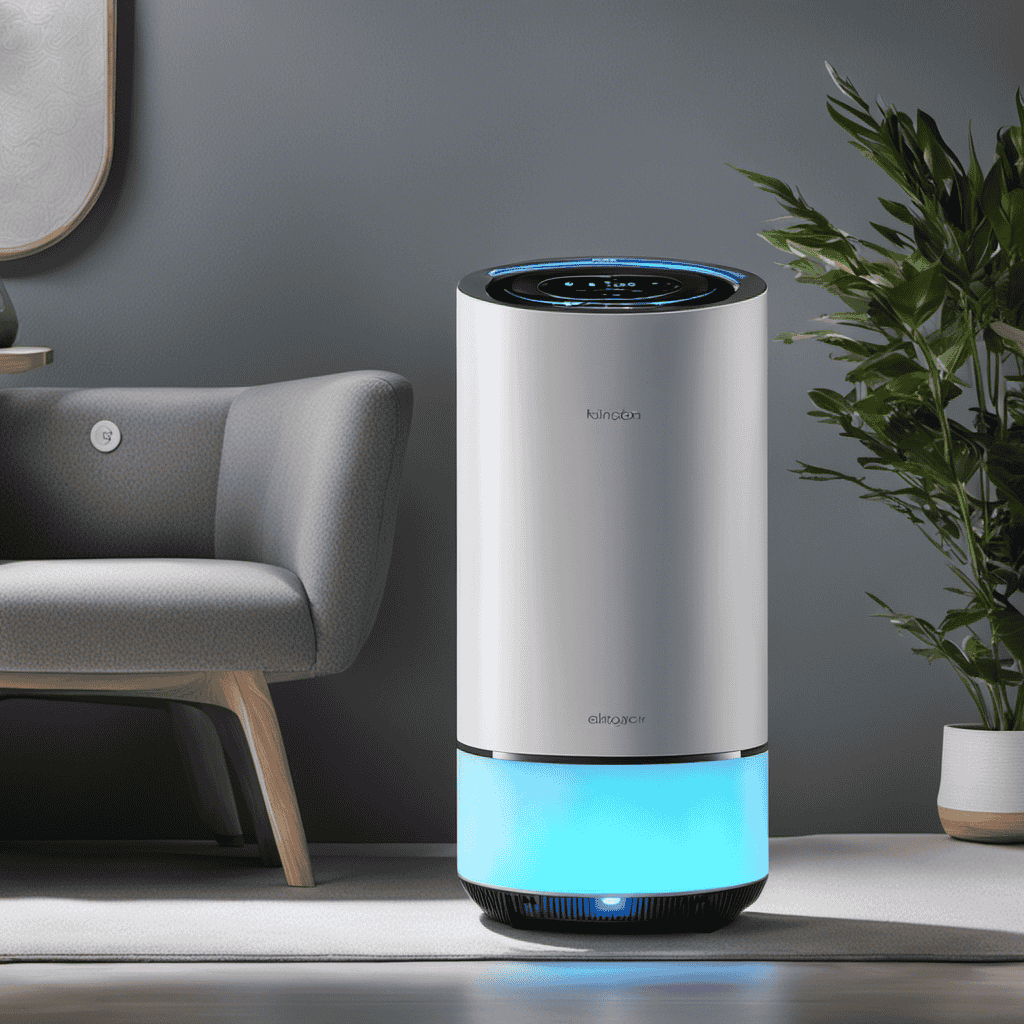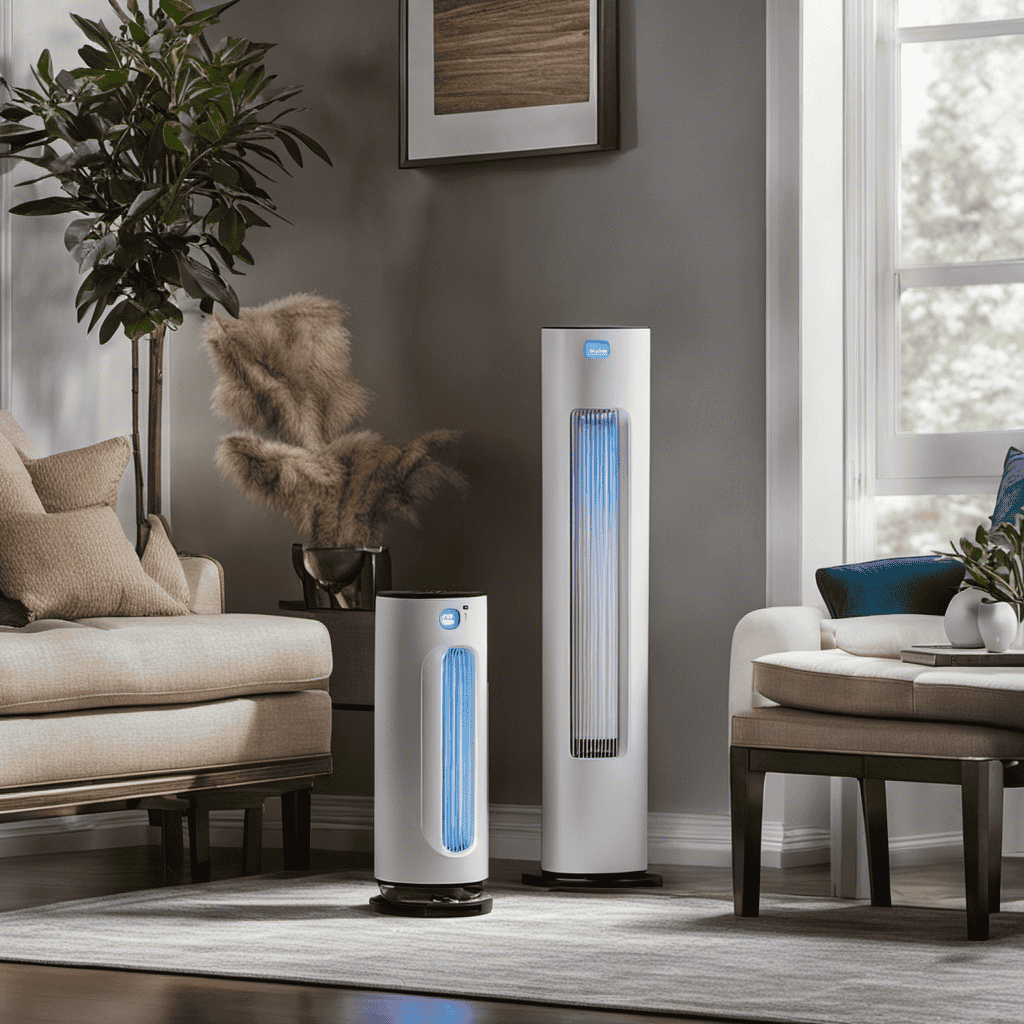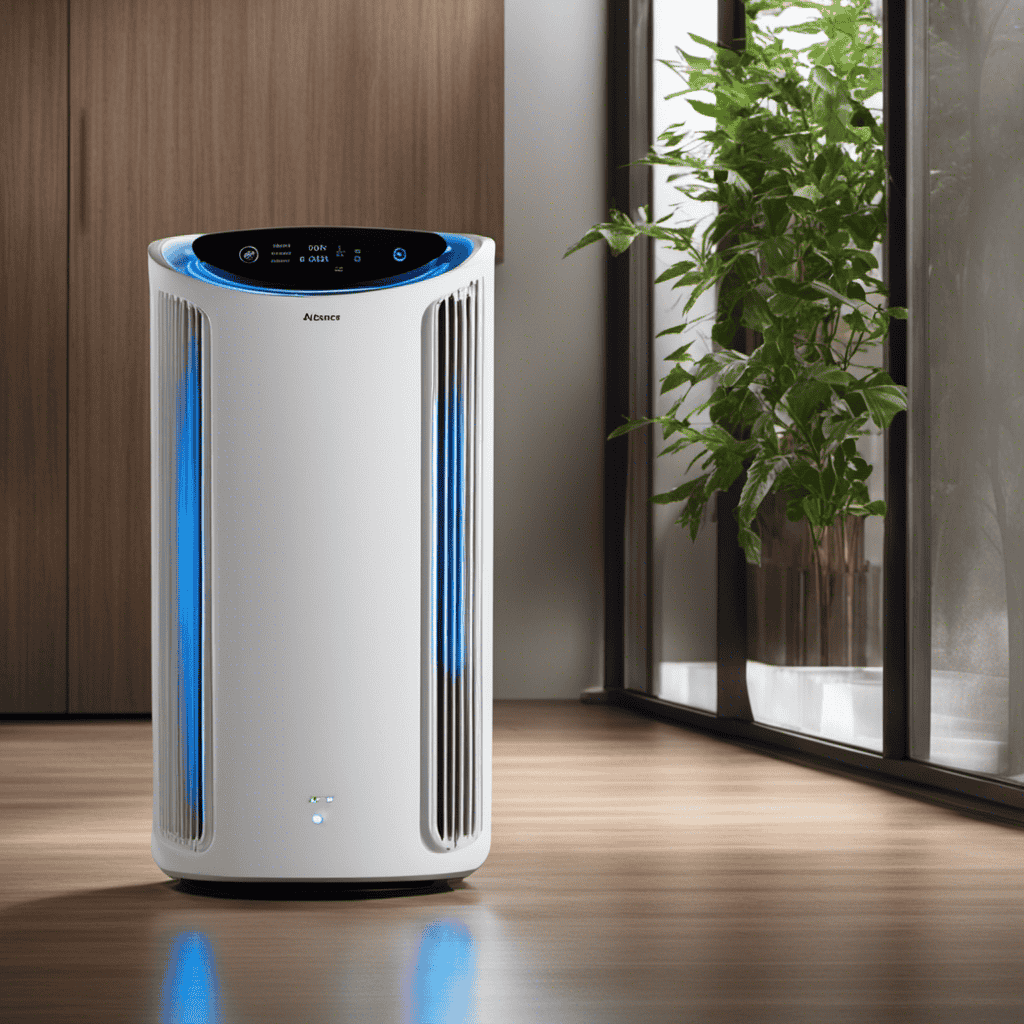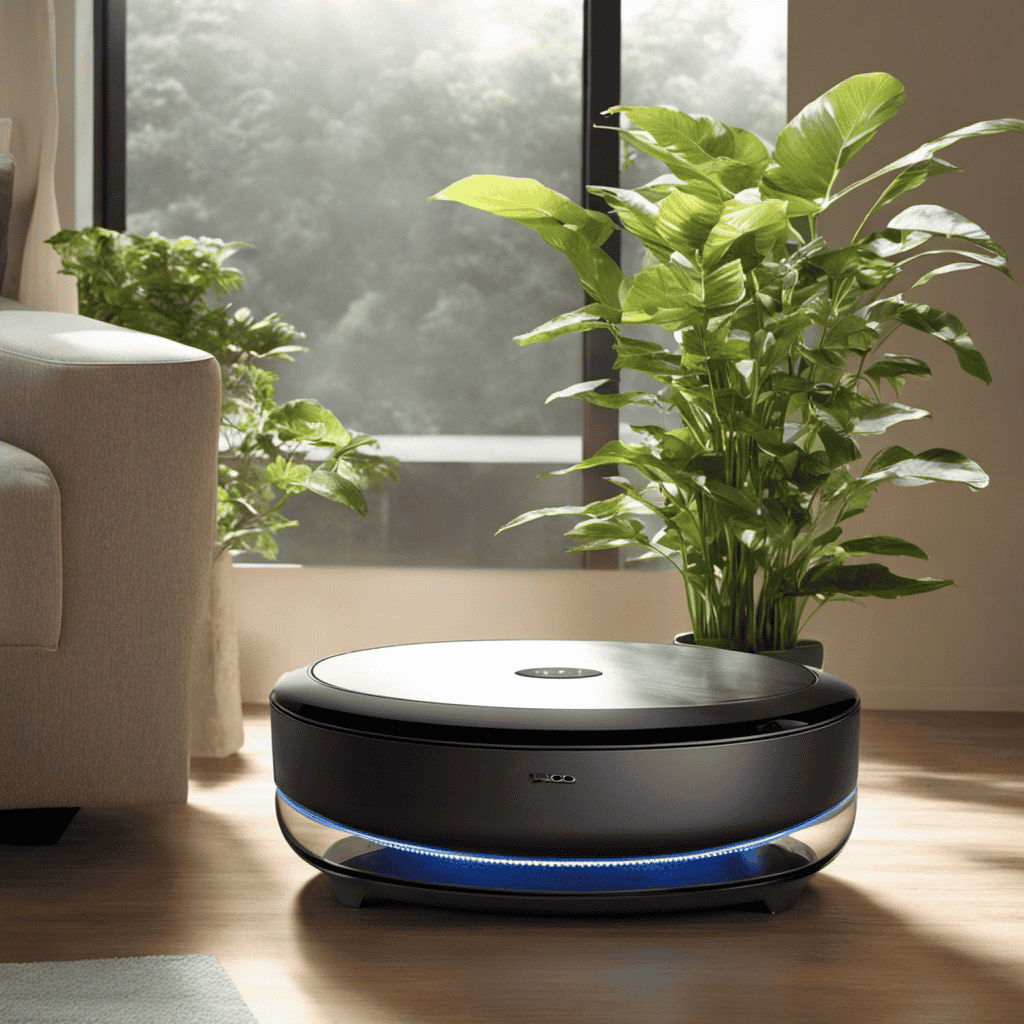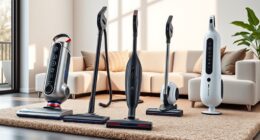I have always been interested in the various modes available on my air purifier, and recently I discovered the ‘Ion Mode.’
So, what exactly is Ion Mode on an air purifier? In this article, we’ll delve into the science behind it, how it works, and the benefits it offers.
We’ll also explore the differences between ion mode and other purification methods, its effectiveness against allergies and odors, as well as some maintenance tips.
Stay tuned to choose the right air purifier with this intriguing feature.
Key Takeaways
- Ion mode on air purifiers releases negatively charged ions that attach to airborne particles.
- The ions make the particles heavier, causing them to fall to the ground or stick to surfaces, effectively removing contaminants from the indoor environment.
- Ion mode can help improve the quality of the air we breathe by removing harmful substances like dust, pollen, and pet dander.
- While ion mode is beneficial, it should be used in conjunction with other purification methods, such as HEPA filters, for comprehensive air cleaning.
The Science Behind Ion Mode
In ion mode, the air purifier releases negatively charged ions that attach to airborne particles, making them heavier and causing them to fall to the ground or stick to surfaces around you. This process plays a crucial role in air purification by effectively removing contaminants from the indoor environment.
When the air purifier generates these ions, they disperse into the air and come into contact with pollutants such as dust, pollen, and pet dander. The negatively charged ions attach to these particles, altering their electrical charge and causing them to clump together. As a result, the particles become too heavy to remain suspended in the air and either settle on the floor or adhere to nearby surfaces.
This mechanism significantly improves indoor air quality by reducing the number of airborne pollutants. Now, let’s delve deeper into how ion mode works and its benefits.
How Does Ion Mode Work
The way ion mode functions is by releasing negatively charged ions into the surrounding air. These ions attach themselves to harmful particles, such as dust, pollen, and pet dander, making them heavy and causing them to fall out of the air.
Here are three key ways in which ion mode purifies the air:
- It effectively removes pollutants from the air, improving overall air quality.
- It helps reduce the presence of allergens, providing relief for individuals with allergies or respiratory conditions.
- It can neutralize odors by eliminating the molecules that cause them, leaving the air fresh and clean.
Ionization has several benefits in air purifiers. It enhances the purification process by capturing smaller particles that may have been missed by filters. Additionally, it can help alleviate symptoms related to poor air quality, promoting a healthier living environment.
Now, let’s explore the benefits of ion mode in air purifiers in more detail.
Benefits of Ion Mode in Air Purifiers
Using ion mode in air purifiers can greatly improve the quality of the air we breathe. Ion mode works by releasing negative ions into the air, which attach to particles and pollutants, causing them to become heavier and fall to the ground or stick to surfaces. This helps to remove harmful substances such as dust, pollen, and pet dander from the air.
However, it is important to note that ion mode does have some disadvantages. For example, it produces ozone, which can be harmful to our health in high concentrations. Additionally, ion mode is not as effective as HEPA filters in removing smaller particles and allergens. Comparing ion mode to HEPA filters, the latter is considered more efficient in capturing particles as small as 0.3 microns.
Understanding ionization in air purifiers can help us make informed decisions about choosing the right mode for our needs.
Understanding Ionization in Air Purifiers
By understanding how ionization works in air purifiers, you can make better decisions when choosing the right option for your needs.
Ion mode is a popular feature in many air purifiers, and it works by releasing negatively charged ions into the air. These ions attach themselves to airborne particles, such as dust, pollen, and pet dander, making them heavier and causing them to fall to the ground or be easily caught by the air purifier’s filters. This helps to remove these particles from the air, improving indoor air quality.
However, there are some misconceptions about ion mode, such as the belief that it produces harmful ozone, which is not true for most modern air purifiers. It’s important to do your research and choose an air purifier with ion mode that has been tested and certified to meet safety standards.
- Ion mode helps to remove airborne particles from the air
- It can improve indoor air quality by making particles heavier and easier to capture
- Modern air purifiers with ion mode are generally safe and do not produce harmful ozone.
Differences Between Ion Mode and Other Purification Methods
One key difference between ion mode and other purification methods is the way in which they capture and remove airborne particles.
In ion mode, an air purifier releases negatively charged ions into the air. These ions attach to airborne particles, making them heavier and causing them to fall to the ground or stick to surfaces. This process is known as ionization.
Other air purification methods, such as HEPA filters or activated carbon filters, physically trap or adsorb particles, removing them from the air.
While ion mode can effectively remove particles from the air, it is important to note that it does not actually eliminate the particles. They may still be present on surfaces and need to be cleaned regularly.
Now, let’s explore some common misconceptions about ion mode.
Common Misconceptions About Ion Mode
Don’t believe the misconception that ion mode completely eliminates particles from the air. While ion mode does have some benefits in air purification, it is important to understand its limitations.
Here are three common misconceptions about ion mode:
-
Ion mode removes all particles: Ion mode does help to remove some particles from the air by charging them and causing them to stick to surfaces or other particles. However, it is not capable of eliminating all particles, especially those that are larger or heavier.
-
Ion mode is harmful to health: There is a misconception that ion mode produces harmful ozone. While it is true that some ionizers can produce ozone, modern air purifiers with ion mode are designed to minimize ozone production and meet safety standards.
-
Ion mode replaces the need for other purification methods: Ion mode is just one of many air purification methods available. It is often used in conjunction with other technologies, such as filters, to provide comprehensive air cleaning.
It is important to be aware of these misconceptions to make informed decisions when using air purifiers with ion mode. Understanding its limitations can help ensure that you choose the right purification method for your needs and minimize any potential health impacts.
Safety Considerations for Ion Mode
When using ion mode, it’s essential to consider safety precautions to protect yourself and those around you. While ion mode can be effective in purifying the air, it also comes with potential health risks. The release of ions into the air can create ozone, which can irritate the respiratory system and worsen existing respiratory conditions. To mitigate these risks, it’s important to ensure proper ventilation in the room and to limit exposure to the ionized air. Additionally, regular maintenance and cleaning of the air purifier is crucial to prevent the buildup of harmful particles and maintain optimal performance. By following these safety considerations, you can enjoy the benefits of ion mode while minimizing any potential harm to your respiratory health.
| Safety Precautions |
|---|
| Ensure proper ventilation in the room |
| Limit exposure to ionized air |
| Regular maintenance and cleaning of the air purifier |
Ion Mode and Allergies: What You Need to Know
When it comes to ion mode on air purifiers, it is important to consider both its effectiveness and safety concerns.
Ion mode is known to be effective in removing certain pollutants from the air, such as dust, pollen, and pet dander.
However, there are also safety concerns associated with ion mode, as it can generate ozone, which can be harmful to human health in high concentrations.
It is crucial to weigh both the effectiveness and safety considerations before using ion mode on an air purifier.
Ion Mode Effectiveness
The ion mode on the air purifier can be effective in improving air quality. When activated, the ion mode releases negatively charged ions into the air, which attach to positively charged particles like dust, pollen, and pet dander. These particles become heavier and settle on surfaces, making it easier to remove them through regular cleaning.
However, it is important to note that ion mode has its limitations. It may not be as effective in removing larger particles or volatile organic compounds (VOCs) from the air. Additionally, while ion mode can help reduce airborne particles, it does not eliminate them completely like HEPA filters do. It is advisable to consider using a combination of ion mode and HEPA filters for optimal air purification.
Now, let’s discuss the safety concerns associated with ion mode.
Ion Mode Safety Concerns?
Activated ion mode can release negatively charged ions into the air. However, there are safety concerns associated with this feature. While ion mode can effectively remove pollutants from the air, it can also have side effects on respiratory health.
The release of negatively charged ions can cause irritation in individuals with respiratory conditions such as asthma or allergies. These ions can attach themselves to airborne particles, making them heavier and causing them to settle on surfaces. This can potentially lead to respiratory problems as these particles can be inhaled.
It is important to consider these safety concerns before using ion mode on an air purifier, especially for those with pre-existing respiratory issues.
Transitioning into the next section, let’s explore how ion mode can also help with odor removal.
Ion Mode and Odor Removal
When it comes to ion mode on air purifiers, many people wonder about its effectiveness in removing odors.
I have found that ion mode can be quite effective in eliminating odors by releasing negatively charged ions that attach to and neutralize odor-causing particles.
However, it is important to note that ion mode should be used with caution and not as the sole method for odor removal, as it may not be as effective on certain types of odors.
Additionally, it is generally safe to use ion mode on a daily basis, but it is recommended to follow the manufacturer’s instructions and guidelines to ensure proper usage and avoid any potential negative effects.
Ion Mode Effectiveness
To maximize the effectiveness of ion mode on your air purifier, make sure to keep the device clean and free from dust or debris. This is because a clean air purifier will produce more ions and distribute them more efficiently.
Ion mode works by releasing negatively charged ions into the air, which attach to positively charged particles like dust, pollen, and pet dander. The ions then become heavy and fall to the ground or get trapped in the air purifier’s filters.
Compared to other purification methods, ion mode is effective in removing smaller particles that may not be captured by filters alone. However, it is important to note that ion mode does not remove gases, odors, or VOCs (volatile organic compounds) from the air.
For comprehensive air purification, combining ion mode with other methods such as activated carbon filters or UV-C light technology is recommended.
Safe for Daily Use?
It’s safe to use the device daily, as long as it is kept clean and free from dust or debris. Air purifiers with ion mode technology are designed to improve indoor air quality by releasing negative ions into the air. These ions attach themselves to pollutants, such as dust, pollen, and pet dander, causing them to become heavy and fall to the ground.
However, it’s important to note that ion mode should not be solely relied upon for air purification. Air purifier filters are still necessary to capture larger particles and filter out harmful gases and odors. Regular maintenance, such as cleaning or replacing the filters, is essential to ensure optimal performance and efficiency.
Maintenance Tips for Ion Mode on Air Purifiers
Make sure you regularly clean the ionization plates in your air purifier to maintain the effectiveness of the ion mode.
The ion mode in air purifiers releases negatively charged ions into the air, which attach to harmful particles like dust, pollen, and smoke, making them heavier and causing them to fall to the ground or get trapped in the filters.
To ensure your air purifier’s ion mode is working optimally, consider the following maintenance tips:
- Clean the ionization plates every 2-4 weeks, or as recommended by the manufacturer, to remove any buildup of particles or residue.
- Use a soft cloth or brush to gently wipe the plates, being careful not to damage or bend them.
- Avoid using water or cleaning solutions that may cause corrosion or other damage to the plates.
Choosing the Right Air Purifier With Ion Mode
When choosing an air purifier with ion mode, I carefully consider the size of the room I want to purify and the specific pollutants I want to target. It is important to select the right air purifier to effectively remove airborne particles and improve indoor air quality.
Air purifiers with ion mode work by emitting negatively charged ions into the air, which attach to airborne particles and cause them to clump together. These clumps then become heavier and fall out of the air, making it easier for the air purifier to capture them.
However, it is essential to note that ion mode alone may not be sufficient to remove all types of pollutants, especially larger particles like dust and pet dander. Therefore, it is recommended to choose an air purifier with additional filtration technologies, such as HEPA filters, to ensure optimal effectiveness.
Frequently Asked Questions
Can Ion Mode in Air Purifiers Generate Harmful Ozone?
Yes, ion mode in air purifiers can generate harmful ozone. It is important to consider the pros and cons of using ion mode, as it can improve air quality in a large room but may also have negative health effects.
How Often Should I Clean or Replace the Ionizing Plates in My Air Purifier?
I clean or replace the ionizing plates in my air purifier regularly to ensure optimal performance. It’s important to follow the manufacturer’s instructions for proper cleaning to maintain the efficiency of the ion mode and effectively remove odors.
Can Ion Mode Effectively Remove Viruses and Bacteria From the Air?
Ion mode on air purifiers can effectively remove pollutants such as dust, allergens, and odors. While it may not specifically target viruses and bacteria, it can contribute to healthier indoor air by reducing overall particle levels.
Is Ion Mode Suitable for People With Respiratory Conditions Like Asthma?
As someone with asthma, I’ve researched the effectiveness of ion mode on air purifiers. From my findings, ion mode can reduce indoor air pollution, but other technologies like HEPA filters may be more beneficial for respiratory conditions.
Can Ion Mode in Air Purifiers Remove Pet Dander and Allergens?
Ion mode on air purifiers can effectively reduce pet dander and allergens. It has its pros and cons for allergy sufferers. While it can help remove particles, it may also produce ozone, which can irritate respiratory conditions.
Conclusion
In conclusion, after exploring the concept of ion mode on air purifiers, it is evident that this feature offers numerous benefits. With its ability to release negatively charged ions into the air, ion mode helps to neutralize pollutants, allergens, and odors effectively. This purification method works by attracting and trapping particles, creating cleaner and fresher indoor air.
However, it is important to note that regular maintenance is essential to ensure optimal performance. Overall, ion mode is a valuable addition to air purifiers, providing an efficient and reliable way to improve air quality.
As the saying goes, ‘Clean air is the elixir of life.’
